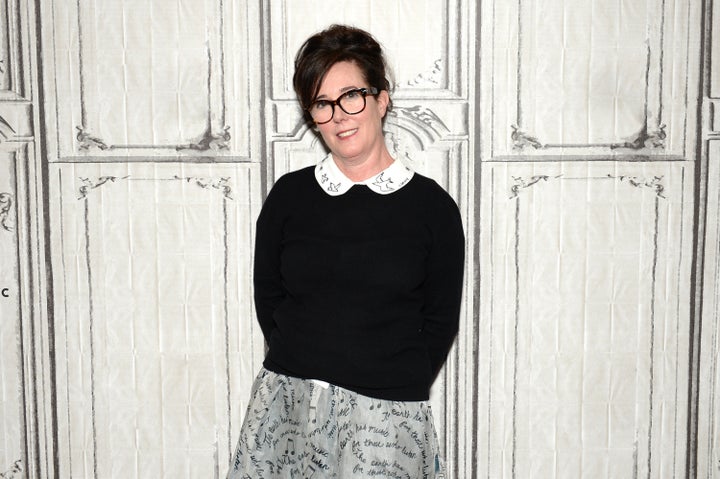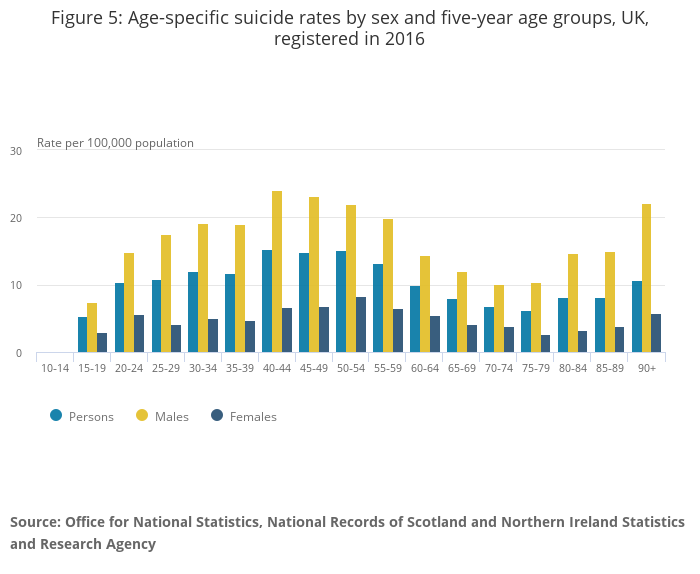
Last week designer Kate Spade and chef Anthony Bourdain tragically took their own lives – Spade was 55 and Bourdain was 61.
Suicide prevention campaigns are often aimed younger people, but figures from the Office for National Statistics show that in the UK people aged 40 to 60 are the most likely to take their own lives, with the suicide rate highest for men between the ages of 40 and 44 years. For women, the most common age to complete suicide is between 50 and 54.

Suicide happens for a complex range of reasons, so it is impossible to highlight one particular cause that might increase suicide rates among people in middle age, explains Rachel Boyd, information manager at mental health charity Mind.
“Behind these statistics there are individuals with their own lives and their own set of circumstances, and it’s really important when talking about suicide to not try to explain things that we may never know the truth of,” she says.
There are, however, some contributing causes that might apply for both men and women. Financial difficulty, relationship pressures and family struggles can impact mental health at any age but these issues can be particularly acute for those between the ages of 40 and 60.
“Certainly people in that age group might quite often be trying to support younger members of their family, but also older parents, and feeling quite a lot of responsibility for the people around them,” Boyd explains.
During our twenties and thirties many of us become accustomed to career progression, but if this stalls in middle age, or we experience redundancy, feelings of entrapment may also contribute towards mental ill health. “In that age range you perhaps start to think ‘maybe those options are no longer open to me’ - it can be really difficult for people to talk about emotions of hope, or lack of hope,” Boyd explains.
Middle age can also be a time when physical health begins to decline, which can in turn have an impact on mental health.

While there is a growing awareness of mental health issues stigma is still prevalent among middle aged people. This can stop men in particular accessing the support they need, argues Dr Paul McLaren, consultant adult psychiatrist at the Priory’s Wellbeing Centres in London and medical director of its hospital in Kent. “Men still struggle to talk about their emotions and probably feel more stigmatised if they have to do so. That leads to greater isolation and they are less likely to seek help with illnesses such as depression,” he says.
Men make up around three-quarters of all suicide deaths in the UK. However, Dr McLaren says the numbers of men and women having suicidal thoughts across genders are quite even; while more men complete suicide, research suggests more women attempt it.
“Men tend to use more dangerous methods when they attempt suicide,” he explains. “In the past men have tended to use alcohol to manage painful feelings and the combination of alcohol and depression is particularly toxic and dangerous.”
Although numbers of male deaths by suicide increase after 40, suicide is the biggest killer of men under the age of 45. The difference is that middle-aged people are also at an increased risk of death by other illnesses, such as cancer, meaning suicide is no longer the “biggest killer”.
Dr Antonis Kousoulis, assistant director at the Mental Health Foundation, explains why young people are frequently the target of awareness campaigns: “There’s a big push on early intervention, a lot of charities are focussing on the idea that the earlier we start these conversations, perhaps we can change things later down the line as well. So that will be a positive way of looking at it.”
He adds that young people are an easy to access group compared to their parents, because they are often still in school or higher education. “With adults we need to get into places where we wouldn’t traditionally talk about suicide and psychological hazards, like workplaces,” he says. “There are attempts to reach people in this age group at work, with line manager training, for example, and there is some work in specific high risk communities such as among those with drug abuse or alcohol abuse problems.”
Both Dr Kousoulis and Dr McLaren would like to see more funding to create additional accessible mental health support for middle aged people. But for Boyd, rather than focussing on “young versus old” or “men versus women”, better campaigns are needed to reach everyone at risk of suicide so they know what support is out there, then feel confident accessing it.
“I want to emphasise the importance for anyone who is worried about themselves or someone else about reaching out,” she says. “It might be really scary to say that you might be having thoughts about suicide or feeling really low, but even the act of just telling someone can be really powerful and can be an important first step. People might feel really alone, but there is help and support out there.”
Useful websites and helplines:
- Samaritans offers a listening service which is open 24 hours a day, on 116 123 (UK and ROI - this number is FREE to call and will not appear on your phone bill.)
- Mind, open Monday to Friday, 9am-6pm on 0300 123 3393
- The Mix is a free support service for people under 25. Call 0808 808 4994 or email: help@themix.org.uk